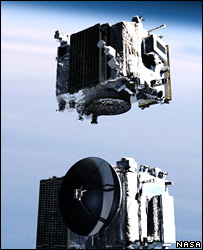Solar flares throw billions of tons of material into space

The American space agency NASA launched two spacecraft this weekend designed to provide XNUMXD movies of the sun. The STEREO mission will investigate the violent eruptions from the Sun known as coronal mass ejections.
These eruptions create huge clouds of energetic particles capable of causing magnetic storms, disrupting the power supply on Earth and interfering with wireless and satellite communications. The mission is expected to help researchers predict magnetic storms.
These eruptions from the corona are what drive the physics of the Sun today," said Mike Kaiser, chief scientist of the STEREO Project at NASA's Goddard Center. "With the help of stereo, we seek to understand how the eruptions begin and how they move into the solar system.
Both spacecraft were launched from one Delta 2 rocket from Cape Canaveral. These are two almost identical spacecraft that will orbit the sun, but one of them will move faster than its companion to provide stereoscopic images. Technical glitches caused the postponement of previous launch attempts.
Eruptions erupt when "loops" of material from the sun suddenly exit the sun, pushing plasma at a temperature of hundreds of thousands of degrees into space. The plasma consists of electrons and ions of hydrogen and helium. A typical eruption contains a billion tons of material and is moving away from the Sun at about 400 kilometers per second. In most cases, these eruptions are directed away from Earth, but some of them are moving in our direction. When this happens, the particles and the magnetic charge they carry can cause unwanted results.
"When a strong storm hits and the other conditions adjust, you get disturbances to the high voltage lines and the spacecrafts exposed to high-energy electrons and protons. said Dr. Kaiser.
These particles are dangerous for astronauts and even airlines whose routes pass over the pole are worried about them because they can blind the communications on planes, and increase the amount of radiation absorbed by crew members and passengers. "If we knew when these storms were going to hit, we could take preventive measures." said.
So far, because solar observers look directly at the sun, the exact direction of the eruption cannot be determined. By placing two spacecraft observing Earth's orbit from two separate locations, astronomers will be able to observe storms from the side and quickly know if a cloud of plasma is approaching Earth.
"In the physics of the sun, we can reach new insights whether through the production of new devices with a higher resolution, which allow us to look deeper into the sun or to see from seas that could not be seen before, or to go to other observation points" says Dr. Lika Guhatkurta, also Scientist in the project.
"When stereo spacecraft begin to operate, it will not be a breakthrough in the field of instruments in terms of resolution, but if we see the sun in all three-dimensional exclusion for the first time - all the way from the surface to the earth, it is going to be spectacular."
Stereo spacecraft each contain 16 instruments, including telescopes for imaging the sun in different areas of bandwidth, and technologies for taking particle samples from the eruptions.
The future of astronauts
Stereo spacecraft will transmit their data to NASA and NOAA, the agency responsible for space weather forecasting, and from there it will be used by all satellite operators and airlines. The new information is expected to improve the early warning from a few hours today to two or three days. "Due to the growing dependence on spacecraft and satellites for communication and navigation, the Strau mission is timely.
The Earth's magnetic field gives the planet and its inhabitants a reasonable level of protection, but due to the intention of the space agencies to send astronauts to the moon or even to Mars in the coming decades, there is pressure to study and reach a full understanding of the sun's activity. Bases on the Moon and Mars will also need to incorporate radiation shields, and astronauts will need good advice before venturing outside the protective range of their base.
In August 1972, a strong solar storm was observed, but it died down between the two Apollo missions. If astronauts were on the moon at that time, they would have been exposed to radiation with an intensity of 400 rem
rem (Roentgen Equivalent Man). They could have contracted reading sickness and without prompt medical attention such a level of radiation could be fatal. The energy of solar storms reaches ten to the power of 24 joules. Billions of times more than a bus hitting a wall at 50 km/h. And 100 times the energy stored in the entire arsenal of nuclear weapons around the world." said.
